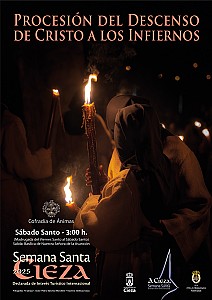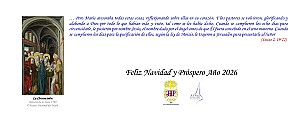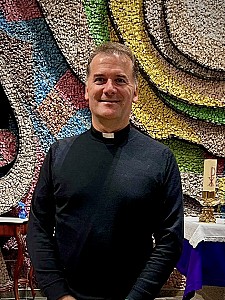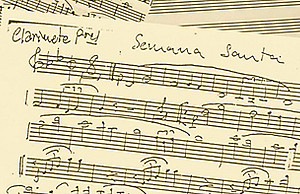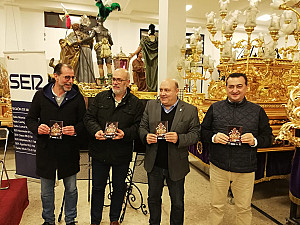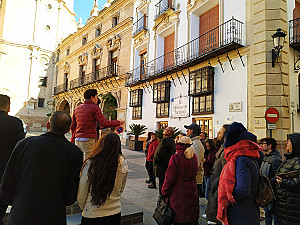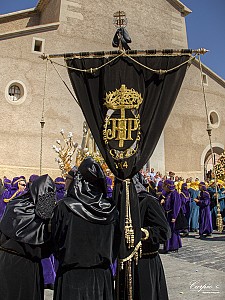| Vox populi |
| La JHP |
| Origen y constitución |
| Se constituye en 1914 |
| Los primeros Estatutos conservados datan de 1958 |
| Día, Procesión y Paso |
| El Estandarte de la Junta de Hermandades Pasionarias encabeza todas las Procesiones |
Los muchos problemas, internos y externos, que comienzan a afectar al buen desarrollo de los Desfiles de Semana Santa en los primeros años del siglo XX, propician, como refleja su Acta Constitucional, y por iniciativa del entonces Párroco de la Basílica de Nuestra Señora de la Asunción, D. Juan José Marco Banegas, que en 1914 se erija una Junta Permanente de Procesiones (conocida también a través del tiempo como Comité General de Procesiones, Junta General Permanente de Procesiones, Junta General de Procesiones, Junta de Procesiones, Junta Local de Procesiones y Junta de Procesiones Pasionarias), que pasará a denominarse definitivamente en 1958 como Junta de Hermandades Pasionarias de Cieza: "En la Villa de Cieza y sacristía de la Parroquia de la misma, previa citación del Párroco, D. Juan José Marco Banegas, para tratar del empeoramiento de las Procesiones de esta localidad, se reunieron D. Juan José Marco, Párroco antedicho; D. Mariano Marín-Blázquez de Castro, Alcalde; D. Arturo Trigueros, Hermano Mayor de Soledad; D. Antonio Aguado Moxó, Hermano Mayor de Jesús; D. Antonio Marín Oliver, Hermano Mayor del Santísimo; D. Pascual Piñera, Hermano Mayor de la Convocatoria; D. Julián Pérez Cano, en representación de D. Juan Pérez López, Hermano Mayor de San Juan; D. Manuel Buitragos, Hermano Mayor de la Verónica; D. Diego Martínez Pareja, Presidente del Casino; D. Pedro Pérez Gómez, en representación de la Prensa local; y D. Manuel Amorós González, en representación del Centro de Juventud Conservadora de Cieza. D. Juan José Marco hizo uso de la palabra para explicar el objeto de la reunión que no era otro que formar una Junta permanente que entendiese y resolviera sobre el mejoramiento y organización de las Procesiones y de cuantas cosas se relacionan con las mismas...".
Sin embargo, no es este el primer intento de las Cofradías ciezanas por coordinarse: ya en 1797 las Cofradías de Jesús y de Nuestra Señora de la Soledad acuerdan que "si algún día ocurriese alguna dificultad para que salgan las procesiones Jueves o Viernes Santo, para la decisión se junten sus vocales con el Sr. Cura y procedan de acuerdo en su resolución". Por otra parte son frecuentes también durante la segunda mitad del siglo XIX y principios del XX ciertos atisbos de corporativismo entre las Cofradías de Jesús, de Nuestra Señora de la Soledad y la Hermandad del Santo Cristo a la hora de contratar a las Bandas de música.
Desde su constitución la Junta de Hermandades Pasionarias ha venido siendo la institución que ha albergado al conjunto de Cofradías ciezanas, dieciocho en la actualidad, constituidas en Asamblea General (Órgano supremo de la Junta y en la que cada Cofradía tiene voz y voto, a razón de un voto por cada una de ellas) y representadas por una Junta Directiva (con voz pero sin voto, exceptuando el voto de calidad del Presidente) que tiene la misión de coordinar y velar por la organización de los Actos y Procesiones de Semana Santa, y de ejecutar los Acuerdos de la anterior, aunando esfuerzos siempre en pos de un proyecto común y solidario.
Como Órgano supremo de gobierno de la Junta de Hermandades Pasionarias, la Asamblea General tiene poder decisorio sobre asuntos tales como Horario e Itinerario de todas las Procesiones (tanto aquellas en las que participa una sola Cofradía como aquellas otras en la que lo hacen varias), organización y normas a seguir en las mismas, supervisión y aprobación de cuantas novedades patrimoniales directamente afectas a los Desfiles Procesionales propongan las Cofradías, aplicación de sanciones disciplinarias...
Surgida para afrontar los problemas socioeconómicos y estructurales que en las primeras décadas del siglo XX amenazaban la continuidad de las Procesiones, tuvo que acometer en los duros años de la posguerra la difícil tarea de reorganizar los Desfiles Pasionarios con el escaso patrimonio que se conservaba, sucediéndose dos décadas de afianzamiento y progresivo desarrollo de las Cofradías y, por añadidura, de nuestra Semana Santa, que revive entonces momentos de esplendor y engrandecimiento; esplendor y engrandecimiento que se verán nuevamente multiplicados en las décadas finales del siglo, merced tanto a las intensificadas inversiones de las Cofradías en la conservación y ampliación de su patrimonio particular como a las actuaciones conjuntas de las mismas encauzadas a través de la Junta de Hermandades Pasionarias.
Así, en 1970 se construye la 'Casa de los Santos' (posteriormente varias Cofradías adquirirán su propia Casa de Hermandad), convertida hoy en Casa-Museo de la Semana Santa de Cieza, que alberga un número importante de Pasos en una de sus plantas y que destina la otra a Salón de Juntas, Sala de Exposiciones y Secretaría, y dependencias de las distintas Cofradías; y en la década siguiente, la Junta de Hermandades Pasionarias asume la organización de los Actos en honor a Nuestra Señora la Santísima Virgen del Buen Suceso, Patrona de Cieza, de cuya Hermandad y patrimonio se hizo cargo, como sucederá también a partir de 1998 con la Procesión del Santísimo el día del Corpus Christi.
La década de los ochenta contemplará también la creación y consolidación del Acto de Convocatoria, Procesión de los Estandartes y Pregón en la mañana del Domingo de Pasión; y la instauración sucesiva de los Concursos de pintura y fotografía para la elección del Cartel Anunciador de Semana Santa. Asimismo comenzarán a hacerse habituales también los ciclos de conferencias y las exposiciones relacionadas con la Semana Santa.
Los años noventa han sido testigos de la Declaración de Interés Turístico Regional para nuestros Desfiles Procesionales (1993); de la creación (1994) del Estandarte de la Junta de Hermandades Pasionarias (bordado en oro sobre terciopelo negro por María Dolores Camacho Lucas) que portan tres nazarenos ataviados con las tradicionales túnicas de Cieza (realizadas por Piedad del Baño Montiel en terciopelo negro con adornos dorados y complementadas con el típico gorro de ‘verdugo’) y que como grupo de rompimiento viene a ocupar el lugar de un grupo escultórico proyectado a finales de la década de los sesenta que nunca llegó a realizarse; de la recuperación de la tradicional Tamborada del Viernes de Dolores; de las primeras ediciones (1995 y 1999) de las marchas y pasodobles propias de la Semana Santa de Cieza (entre ellas la marcha de procesión ‘Semana Santa ciezana’ y el pasodoble ‘La Cortesía’, escritas en 1994 por el Maestro José Gómez Villa, compositor ciezano, por encargo de la propia Junta); de la creación de una Comisión de Arte que asesore en cuantas innovaciones, restauraciones o modificaciones atañan al patrimonio de los Desfiles Procesionales en materia de Pasos, Enseres y Vestuario (1995); a la restauración y representación del Auto del Prendimiento (1996); y a las sucesivas convocatorias, desde 1995, de Concursos de Dibujo y Narración corta, amén de la organización de una larga serie de cultos, exposiciones, actos y actividades de carácter cultural y social, a la que con los suyos propios se han ido sumando a su vez las Cofradías.
Por último y en lo que a la divulgación de nuestras Procesiones se refiere, la labor de la Junta de Hermandades Pasionarias se centró desde sus orígenes en la publicación de la Revista de Semana Santa, hoy Revista ‘El Anda’. Con el paso de los años y como complemento de esta han ido viendo la luz la Guía de Actos y Procesiones, el Cartel Anunciador y el Cartel del Pregón; con carácter excepcional, las ediciones de la Revista del año 2008 y 2010, incorporaron sendos vídeos que relataban, bajo el título ‘Cuando los Santos subieron al monte’, el proyecto 'Lux Fidei'. Ya en el año 2014, con motivo de la celebración del centenario de la institución, se editaron dos películas sobre la Semana Santa de Cieza (‘El Pórtico de la Gloria’ y ‘La Primavera del Mundo’), realizadas por Enrique Centeno González; y se maquetó el útlimo disco de marchas procesionales. A todo ello hay que sumarle, los vídeos promocionales de la Semana Santa, que acumulan en los distintos canales de distribución cerca de medio millón de reproducciones, además de otras publicaciones puntuales de carácter monográfico.
Todo este trabajo dió sus frutos en el año 2011, cuando la Semana Santa de Cieza fue Declarada de Interés Turístico Nacional, reconocimiento que destacó su valor y singularidad. Y ya en el año 2023, se alcanzó un nuevo hito al obtener la Declaración de Interés Turísitco Internacional, que puso en valor su rica tradición, patrimonio escultórico y musical.
Al frente de la Junta de Hermandades Pasionarias se han sucedido como Presidentes desde su constitución: Rvdo. D. Juan José Marco Banegas (1914-1921), Rvdo. D. José Espín Jiménez (1921-1925), Rvdo. D. Mariano Aroca López (1925-1936) –en 1935 Comisario de Procesiones D. Francisco Marín González-, Rvdo. D. Antonio Sánchez Oliva (1940-1954), Rvdo. D. Manuel Pereira Navarro (1955-1958) –entre 1940 y 1958, Comisario de Procesiones D. Julián Pérez Cano-, D. Mariano Camacho Blaya (1959-1964), D. Fulgencio Serra Peña (1964-1965), D. Antonio Lucas Saorín (1965-1966), D. José Lucas Avellaneda (1966-1968) –nombrado en la década de los noventa Comisario de Honor, cargo que desempeñó hasta su muerte en 1994-, D. Fulgencio Serra Peña (1969-1973), D. Antonio Galindo Tormo (1973-1979), D. José Motos Marín (1979-1982), D. José Salmerón Salmerón (1982-1988), D. José Gómez Rubio (1988-1993) y D. Rafael Salmerón Pinar (1993-2011), al que ha sucedido D. Joaquín Gómez Rubio (2011-actualidad). La gestión de todos ellos al frente de la Junta de Hermandades Pasionarias se ha concretado en más de cien años de actividad continua por parte de las Cofradías para conformar la Semana Santa de Cieza como todos la conocemos y como entre todos hemos querido que sea.
Fotografía de Manuel Carpio.
© Junta de Hermandades Pasionarias de Cieza
